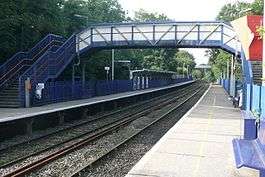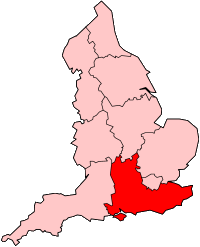Reading–Basingstoke line
| Reading–Basingstoke line | |
|---|---|
|
Mortimer station | |
| Overview | |
| Type | Heavy rail |
| System | National Rail |
| Status | Operational |
| Locale | South East England |
| Termini |
Reading Basingstoke |
| Stations | 5 |
| Operation | |
| Opened | 1848 |
| Owner | Network Rail |
| Operator(s) | |
| Rolling stock | |
| Technical | |
| Number of tracks | 2 |
| Track gauge | 1,435 mm (4 ft 8 1⁄2 in) standard gauge |
| Electrification | Planned 25kV OHLE by 2018 |
| Reading–Basingstoke line | ||||||||||||||||||||||||||||||||||||||||||||||||||||||||||||||||||||||||||||||||||||||||||||||||||||||||||||||||||||||||||||||
|---|---|---|---|---|---|---|---|---|---|---|---|---|---|---|---|---|---|---|---|---|---|---|---|---|---|---|---|---|---|---|---|---|---|---|---|---|---|---|---|---|---|---|---|---|---|---|---|---|---|---|---|---|---|---|---|---|---|---|---|---|---|---|---|---|---|---|---|---|---|---|---|---|---|---|---|---|---|---|---|---|---|---|---|---|---|---|---|---|---|---|---|---|---|---|---|---|---|---|---|---|---|---|---|---|---|---|---|---|---|---|---|---|---|---|---|---|---|---|---|---|---|---|---|---|---|---|
| ||||||||||||||||||||||||||||||||||||||||||||||||||||||||||||||||||||||||||||||||||||||||||||||||||||||||||||||||||||||||||||||
|
Miles measured from London Paddington † except Basingstoke which is from London Waterloo | ||||||||||||||||||||||||||||||||||||||||||||||||||||||||||||||||||||||||||||||||||||||||||||||||||||||||||||||||||||||||||||||
The Reading–Basingstoke line is a short railway link between the South Western Main Line and the Great Western Main Line, constructed by the Great Western Railway between 1846 and 1848. The line is served by Great Western Railway local services between Reading and Basingstoke, which stop at the intermediate stations Reading West, Mortimer and Bramley. The line is also an important through route for longer distance passenger and freight services: CrossCountry services from Bournemouth and Southampton to Birmingham and the North of England and freight trains between Southampton Docks and the Midlands use the line. The section of line between Southcote Junction and Basingstoke was resignalled in 2006, to increase the capacity of the line.
History
A railway was originally proposed in 1843 as a link between Basingstoke, Newbury and Didcot by the London and South Western Railway. A new company, the Berks and Hants Railway had the idea of building the link between Basingstoke and Reading. The Berks and Hants Railway joined the Great Western Railway before the track was laid.
The railway was built by the GWR, with the engineer Isambard Kingdom Brunel, who used broad gauge, from Reading's railway station to Basingstoke. Since the main line at Basingstoke used standard gauge, it was impossible for the railways to share the same station. The GWR built a small station to the north of the L&SWR's station.
In 1846, prior to the line being built, the Gauge Commissioners (Regulation of Gauge Act) recommended to Parliament that the line from Reading to Basingstoke should be built to standard gauge. In 1854 the Great Western was ordered to convert the railway to standard gauge between Reading and Basingstoke by 7 February 1856, or face a fine of £200 each day. However, it was not until 22 December 1856 that a mixed gauge track was opened. Basingstoke kept its separate Great Western station until 1 January 1932 when trains were diverted into the L&SWR station with addition of one platform, still in use today, from the old station.[1]
In 1895, a railway station was opened at Bramley, then in 1917, a large depot was opened at Bramley Ordnance Depot, which had a complex network of sidings.[2] The depot was used to manufacture and store ammunition, and lasted until 1987. Another station was opened at Reading West, and allowed long-distance trains to call at Reading without the need to reverse at Reading's main station. This became less of an issue when diesel multiple unit trains were introduced, which could easily reverse at Reading General.
- A Basingstoke train in platform 2 at Reading
 Reading West, looking towards Basingstoke
Reading West, looking towards Basingstoke- Mortimer, looking towards Basingstoke
 Bramley, looking towards Reading
Bramley, looking towards Reading A Reading train in platform 5 at Basingstoke
A Reading train in platform 5 at Basingstoke
Infrastructure
Since the conversion, the line uses standard gauge. There are two tracks and speed is limited to 75 mph. There is a level crossing at Bramley railway station. The line was due to be electrified by 2017,[3] but this has been delayed until Control Period 6 (2019-2024).[4]
Services
The route sees two stopping services in either direction every hour which are operated by Great Western Railway using Class 165 or Class 166 trains. There were two Class 150 units (illustrated) on the route but these have been redeployed to the Bristol area.[5] A further train in each direction every hour, half-hourly at times, is operated by CrossCountry but this does not call at stations between Reading and Basingstoke. South West Trains previously ran services to Brighton on this route.
Future
The railway is listed with Network Rail as part of route 13, the Great Western main line, and was due to be electrified with 25 kV overhead wiring by 2017[6] as part of the modernisation of the main line.[7] In July 2007, plans were agreed to build a station in Reading south of Southcote Junction in the Green Park business park, serving the southern suburbs of Reading and also the Madejski Stadium. Construction on Reading Green Park railway station was expected to be completed in 2010, the plans were suspended in 2011, but were reinstated in 2013. It is planned to open by December 2018, with electrification along the line at a later date.[8][9][10]
References
- ↑ "Great Western Railway publicity". The Great Western Archive. 2006. Retrieved 22 May 2008.
- ↑ "A History of the Railways around Basingstoke". Basingstoke & District Railway Society. Retrieved 8 January 2016.
- ↑ "Great Western electrification scheme 'one year behind schedule". BBC News. 24 February 2015. Retrieved 8 April 2015.
- ↑ "Network Rail attempt to get Green Park Station project back on track". getreading. getreading. Retrieved 27 January 2018.
- ↑ "Northern gets '150s' from GWR". Modern Railways. Vol. 75 no. 833. February 2018. p. 83.
- ↑ "Great Western electrification scheme 'one year behind schedule". BBC News. 24 February 2015. Retrieved 8 April 2015.
- ↑ "Building a Greater West - London and Thames Valley". Great Western Railway.
- ↑ "Green Park Station trains 'must be ready' for opening". BBC News. BBC. Retrieved 27 January 2018.
- ↑ "Reading Green Park railway station cost increases by £3m". BBC News. BBC. Retrieved 27 January 2018.
- ↑ "Five new rail stations to 'boost' regional economies". BBC News. BBC. Retrieved 27 January 2018.
External links
| Wikimedia Commons has media related to Reading–Basingstoke line. |
